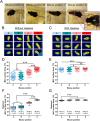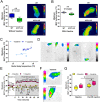An improved method for the precise unravelment of non-shivering brown fat thermokinetics
- PMID: 33637831
- PMCID: PMC7910537
- DOI: 10.1038/s41598-021-84200-1
An improved method for the precise unravelment of non-shivering brown fat thermokinetics
Abstract
Since the discovery of functional brown adipose tissue (BAT) in adult humans, research on BAT gained a new popularity to combat obesity and related comorbidities. To date, however, methods to quantify BAT thermogenesis are often either highly invasive, require advanced equipment, are time consuming or of limited sensitivity. Here we present a simple yet highly effective and minimally invasive protocol for the Precise Unravelment of Non-shivering brown fat thermoKinetics (PUNK) in mice using infrared thermography in combination with Vaseline to brush up the fur between the shoulder blades. We also use physiological and molecular readouts including indirect calorimetry, qPCR and Western Blots to test our protocol. Our study demonstrates that Vaseline before thermography vastly advances the reproducibility and quality of BAT infrared pictures or videos, as it exposes the skin above the BAT for a direct line of sight for the infrared camera and thereby circumvents the well-known problems associated with shaving and anaesthesia. We subsequently validate that this approach does not affect physiological and molecular BAT function, but instead leads to more robust and less variable results when comparing for instance norepinephrine stimulation tests or knockout animals. Taken together, the PUNK protocol for BAT thermography quickly and effectively improves scientific outcomes of this method, and can be easily added to existing paradigms. Consequently, it safes money, time and experimental animals, thereby putting the 3R's principles of animal welfare into practice.
Conflict of interest statement
The authors declare no competing interests.
Figures




Similar articles
-
Concurrent validity of supraclavicular skin temperature measured with iButtons and infrared thermography as a surrogate marker of brown adipose tissue.J Therm Biol. 2019 May;82:186-196. doi: 10.1016/j.jtherbio.2019.04.009. Epub 2019 Apr 20. J Therm Biol. 2019. PMID: 31128647
-
Infrared Thermography for the Detection of Changes in Brown Adipose Tissue Activity.J Vis Exp. 2022 Sep 28;(187). doi: 10.3791/64463. J Vis Exp. 2022. PMID: 36279537
-
Translational Pharmacology and Physiology of Brown Adipose Tissue in Human Disease and Treatment.Handb Exp Pharmacol. 2019;251:381-424. doi: 10.1007/164_2018_184. Handb Exp Pharmacol. 2019. PMID: 30689089
-
Switching on the furnace: Regulation of heat production in brown adipose tissue.Mol Aspects Med. 2019 Aug;68:60-73. doi: 10.1016/j.mam.2019.07.005. Epub 2019 Aug 5. Mol Aspects Med. 2019. PMID: 31325458 Review.
-
Brown adipose tissue and the regulation of nonshivering thermogenesis.Curr Opin Clin Nutr Metab Care. 2012 Nov;15(6):547-52. doi: 10.1097/MCO.0b013e3283599184. Curr Opin Clin Nutr Metab Care. 2012. PMID: 23037904 Review.
Cited by
-
Temperature modulates systemic and central actions of thyroid hormones on BAT thermogenesis.Front Physiol. 2022 Nov 18;13:1017381. doi: 10.3389/fphys.2022.1017381. eCollection 2022. Front Physiol. 2022. PMID: 36467699 Free PMC article.
-
Uncoupling Protein 1 Does Not Produce Heat without Activation.Int J Mol Sci. 2022 Feb 22;23(5):2406. doi: 10.3390/ijms23052406. Int J Mol Sci. 2022. PMID: 35269549 Free PMC article. Review.
-
Orally Induced Hyperthyroidism Regulates Hypothalamic AMP-Activated Protein Kinase.Nutrients. 2021 Nov 24;13(12):4204. doi: 10.3390/nu13124204. Nutrients. 2021. PMID: 34959756 Free PMC article.
-
Maternal thyroid hormone receptor β activation in mice sparks brown fat thermogenesis in the offspring.Nat Commun. 2023 Oct 24;14(1):6742. doi: 10.1038/s41467-023-42425-w. Nat Commun. 2023. PMID: 37875497 Free PMC article.
-
Impaired thyroid hormone receptor signaling in anterior hypothalamic parvalbumin neurons causes bradycardia in male mice.Eur Thyroid J. 2025 May 15;14(3):e250055. doi: 10.1530/ETJ-25-0055. Print 2025 Jun 1. Eur Thyroid J. 2025. PMID: 40334052 Free PMC article.
References
Publication types
MeSH terms
Substances
LinkOut - more resources
Full Text Sources
Other Literature Sources
Molecular Biology Databases

